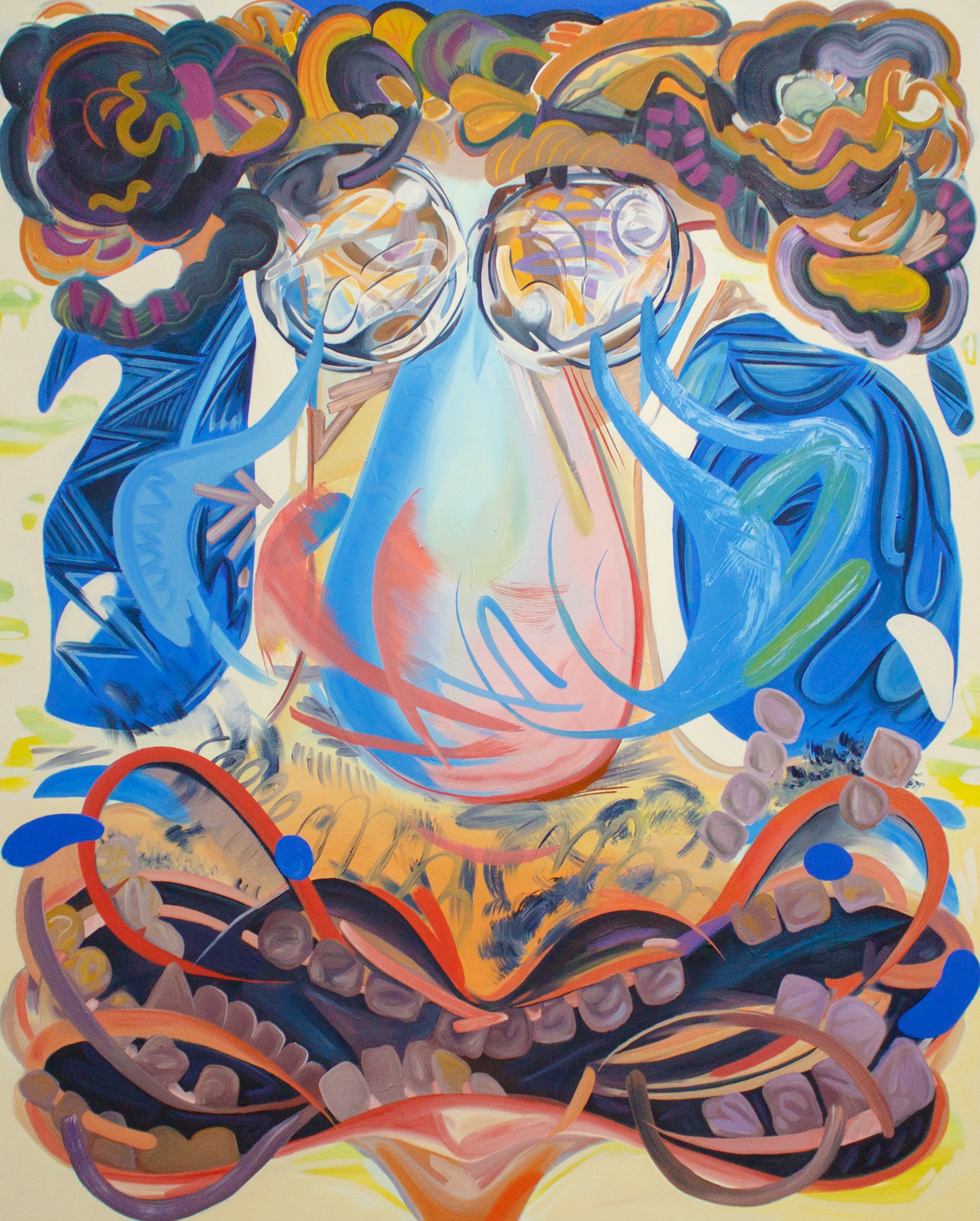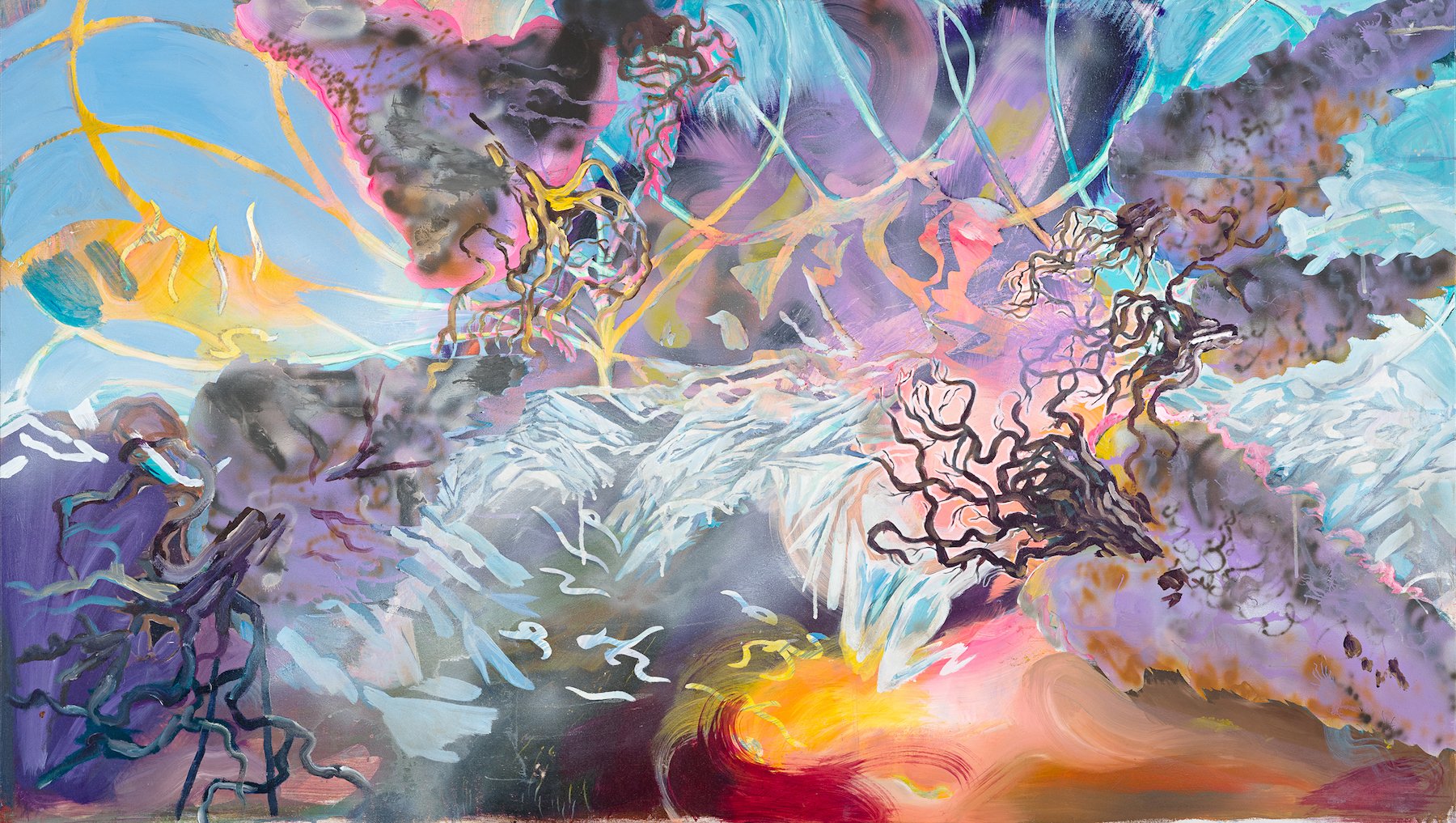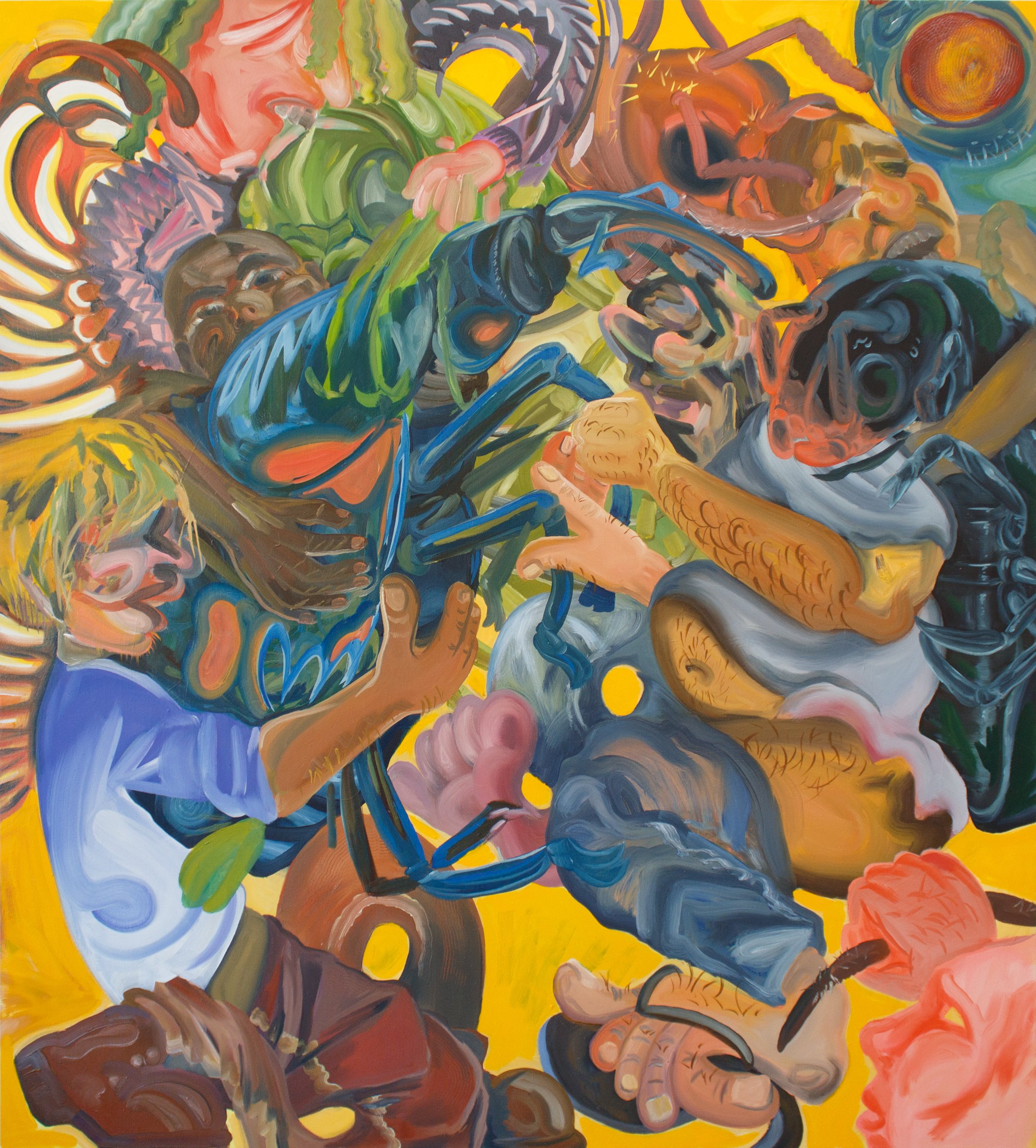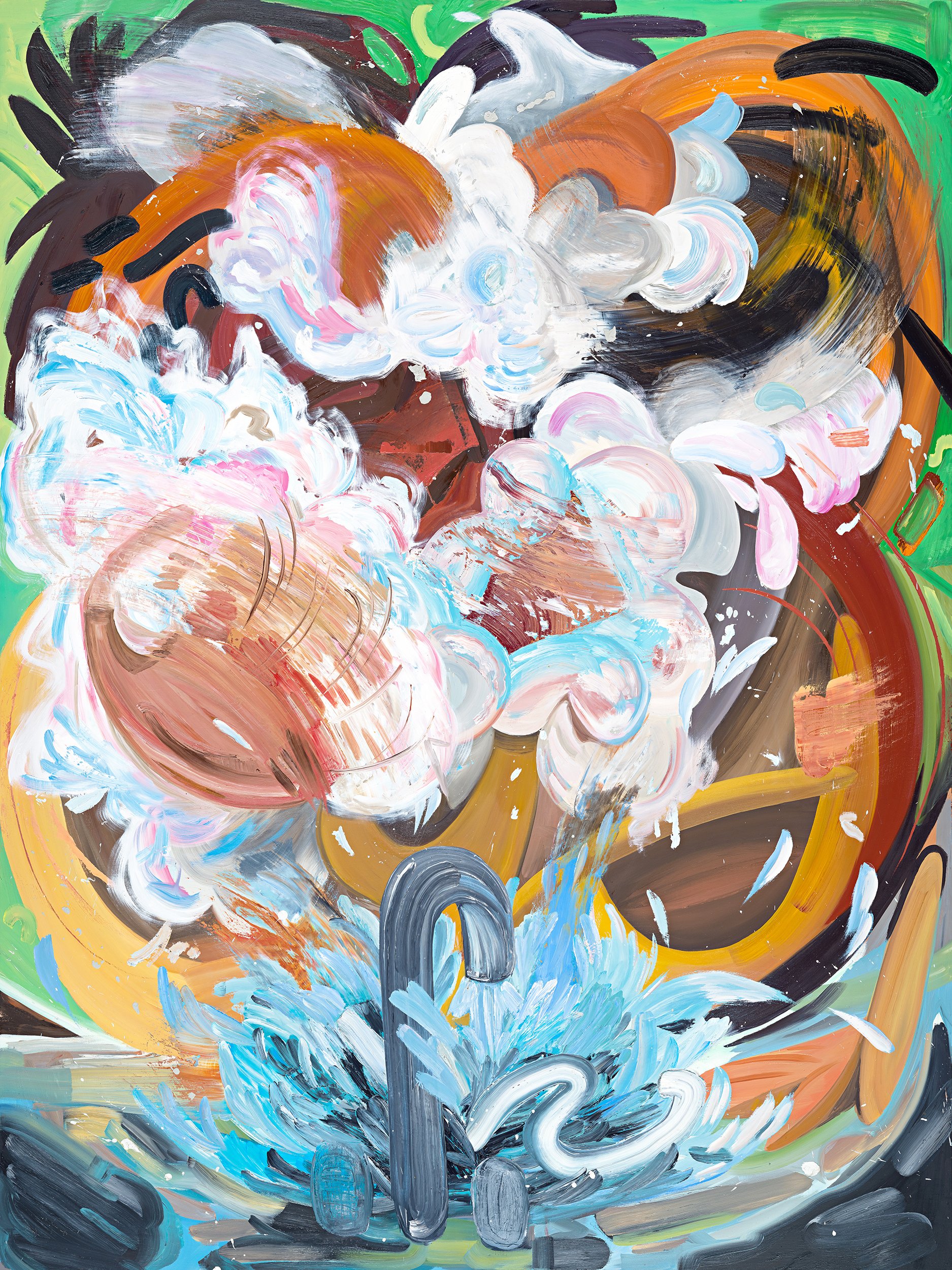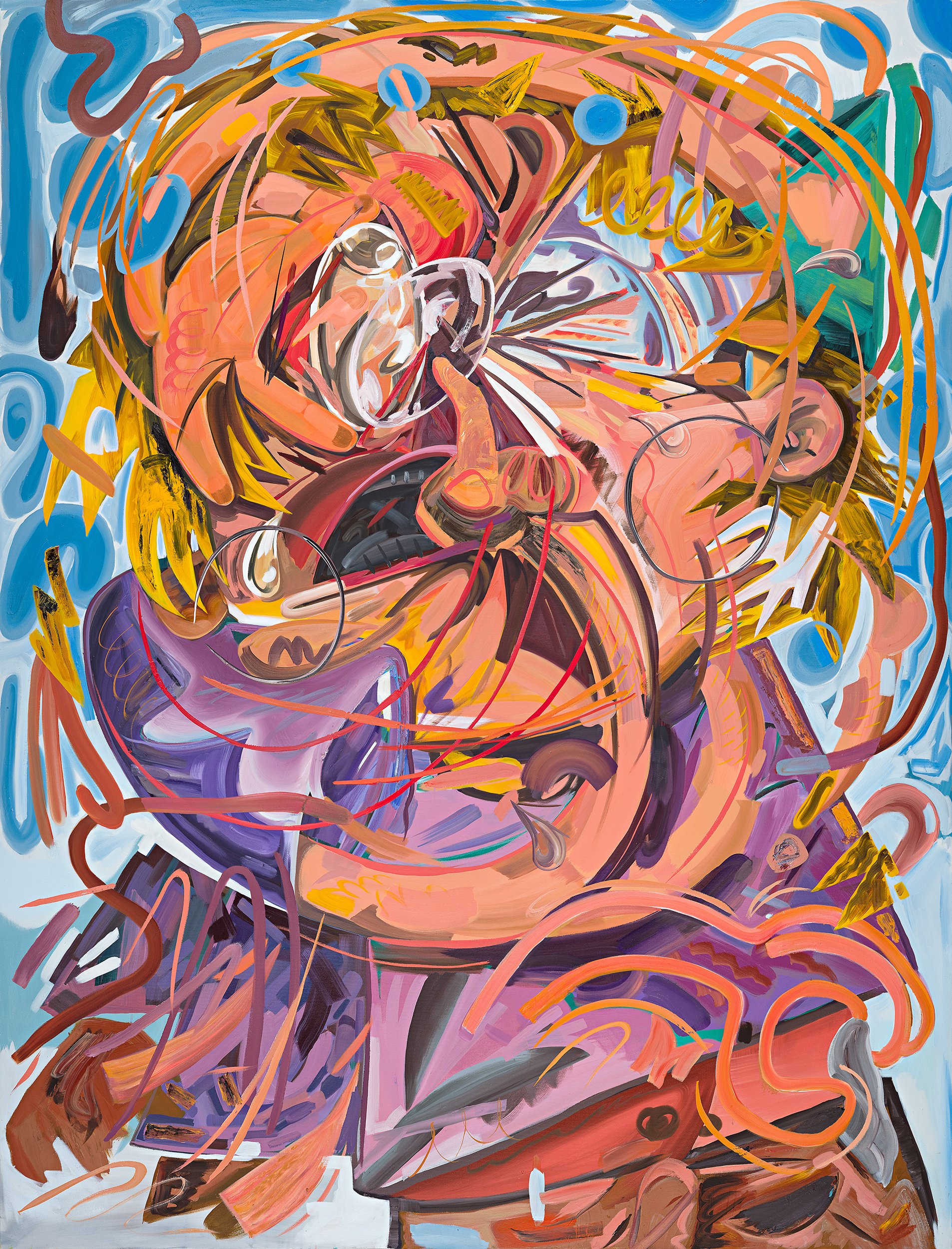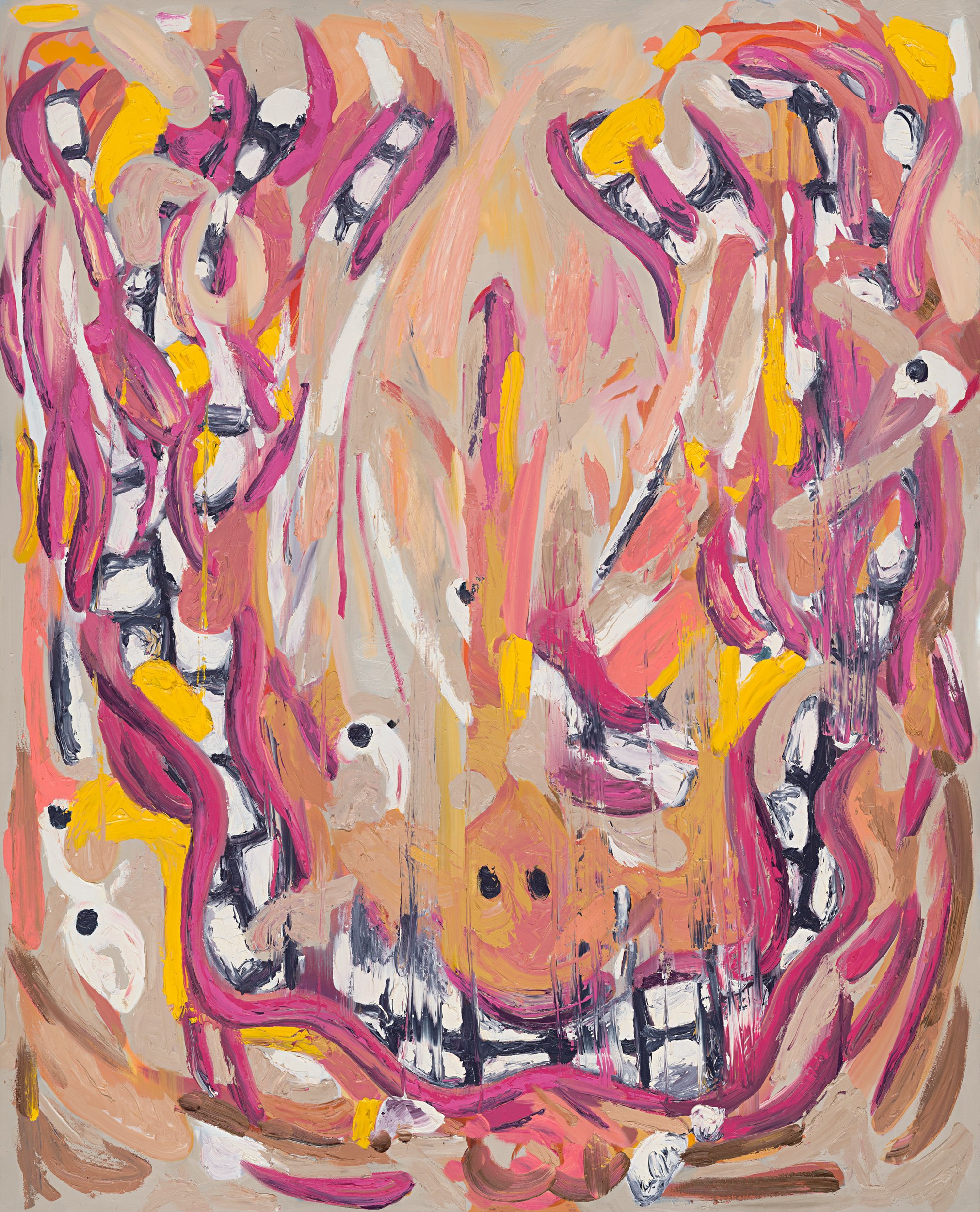Matthew Bacher with HereIn
Heavy Metal Rules, 2021, oil on canvas, 60 x 47 in.
[Image description: A person’s cartoonish head fills the frame. They have pink and yellow skin, neon green hair, and many facial piercings. Horseshoe magnets in the upper left and lower right of the image violently attract tongue and eyebrow piercings away from the face. ]
Unsettling and funny, Matthew Bacher’s paintings direct attention to the tortuous absurdity of living in the human body. His frenzied images appear suspended between representation and abstraction, and, as he says, “could easily read as nonsense.” Drawing on a wide range of historical references— such as Expressionism, Futurism, and the Chicago Imagists— his works radiate a turbulent energy more radical than much contemporary figurative painting. He spoke with HereIn Editor Elizabeth Rooklidge about his driving question: “What can a body do?”
HereIn: You come from a background that might be considered to be unconventional for a contemporary artist. House painting and tattooing, right?
Matthew Bacher: I grew up in a family of house painters, so starting off very young I was sort of forced into that job. I attempted to get out through tattooing and through higher education. So it’s sort of ironic, this transition from tattooing back to painting on these big canvases that I find mirrors my history in my familiar upbringing as a house painter.
Lecture, 2021, oil on canvas, 84 x 68 in.
[Image description: An abstracted portrait of a person with glassy eyes behind spectacles, a large nose, and menacing mouth. Painted in a discordant combination of blue, orange, dark purple, and brown, the portrait projects a sense of pomposity.]
HereIn: In my mind, house painting and tattooing are on the opposite ends of the spectrum in terms of scale and gesture. Do they converge in your work in some way?
Bacher: I think that there is this canonical precedent that overlays house painting and tattooing, like this idea of a structurally-sound tattoo— there’s a formula for producing an image that is going to create longevity on the body. And doing that, I felt in opposition to the things I wanted to create, which weren’t aesthetically pleasing. I really wanted to justify painting trash and have all of these swirling colors and nonsense. I think tattoos are very much related to sense, and to getting that kind of immediacy of the iconography of the image, versus the process itself of understanding what the viewer is looking at.
I'm always trying to understand the subjects in my work. I think painting is, in part, a process of getting to know myself, but also trying to understand something outside of my own limitations. And so through the process of painting, I can create information that I don't specifically understand, and I'm forced to sit with it. It allows me to get outside of myself and to get somewhere else through the material.
Uprooted, 2019, oil on canvas, 55.5 x 31.5 in.
[Image description: A swirling, exploding landscape in purple, blue, yellow, and black, with forms like tree roots across the canvas.]
HereIn: As recently as 2020 you were making paintings anchored in the landscape, but since then you’ve moved to imagery focused on the human body. What prompted that shift?
Bacher: When I moved to San Diego I was a really big naturalist, really engaged in the environment. I was using my work as a way to explore different relationships between nature and human cohabitation. That changed during the pandemic lockdown— I sort of just stayed holed up in my garage. And so it was a flipping inward, and in turn I moved more directly towards the subject. I was also interested in directly implicating the subject versus presenting a narrative with the subject as a surveyor of landscape. I wanted to flip the perception back onto the viewer. But I still think I engage with that kind of naturalistic ideology. I think maybe my paintings are relative to the Fauvist movement, my brushstrokes specifically.
Infestation, 2020, oil on canvas, 46 x 51 in.
[Image description: A chaotic, colorful mass of abstracted figures against a yellow background.]
I’m really interested in a question the philosopher Spinoza brought about, which was, “What can a body do?” I think that there's a crossroads between understanding the body in terms of how it's formally represented and understanding the tension of being in a body. There’s this relation between the playfulness and the torture of being in a body. Of schadenfreude. I think the speed relates to the sense of time and juxtaposition of different positionings that a body can be in.
HereIn: You capture a seemingly uncontainable energy in your paintings— that’s a really tricky thing to pull off. What is your process like? Do you plan your compositions out and create drawings beforehand?
Bacher: I really try not to draw anything beforehand. I find it more exciting coming to a composition and subject matter in the process of painting. It feels more like a conversation between me and the material, which is enough of a reason for me to do it. I apply forms and playful marks that contribute and relate to one another, providing me with a constant revealing of information, and particularly when the paint is wet— I work with oil paints— it’s like the whole surface is alive. So when you put a brushstroke down, it permeates the other brushstrokes around it. The whole surface is moving. And I'm really interested in the life of a painting and how that relates to fluidity, and my own fluidity and motion in executing each brushstroke.
Exfoliate, 2022, oil on canvas, 100 x 72 in.
[Images description: A highly abstracted image that suggests a person vigorously washing their face at a sink.]
In terms of color, I'm interested in the relation between color and how that evokes a sense of emotion in the viewer. In terms of scale, there's a relation to my own bodily scale, and it brings us back the second element of the process— which is just as important— and that’s my own body in relation to the work. Which is what happened during the Expressionist movement, when it was not just about the product, but the labor or the byproduct of the artwork, which is why I prefer to show brushstrokes as brushstrokes. I'm sort of morally opposed to a refined, slick painting, I think because it gets too close to mimicking what the eye can do and steps away from the material aspect of a painting.
Contact, 2022, oil on canvas, 100 x 76 in.
[Image description: Frenetic, swirling brushstrokes fill the frame. The colorful image coheres, just barely, into a figure with light skin, blonde hair, and a purple shirt. They are struggling to put a contact lens in their eye.]
HereIn: One of the things that initially drew me to your work is this somewhat mild but surprising sense of grossness— I’m thinking of the paintings Heavy Metal Rules and Contact, in particular. It’s elicits a productive discomfort. Enlivening, I think.
Bacher: Yeah. A lot of it has to do with the overabundance of visual sensation, or engaging fully in these minuscule tortures or moments of revulsion. In these moments we can sort of step outside our bodies. When you’re putting in a contact, you get it down to this point where you aren't thinking about it. But anybody who has put in a contact for the first time knows it’s awful. And so engaging with that as a valid perception of oneself, engaging with this other side of ourselves. I think that comes from my reading of Donna Haraway’s Cyborg Manifesto and Legacy Russell’s Glitch Feminism. They talk a little bit about that, engaging in aspects of ourselves that we don't necessarily consider to be part of our perceived identity.
Falling Up, 2022, oil on canvas, 84 x 68 in.
[Image description: Gestural, fluid brushstrokes create a U-shape that fills the canvas with a strong sense of upward motion. The beige, pink, and yellow forms suggests a toothy smile, multiple eyes, and a nose.]
HereIn: In the contemporary art world, we’re experiencing a boom in figurative painting. It’s everywhere, to an almost overwhelming degree. Why do you think figurative painting feels so relevant right now?
Bacher: I think it's always been relevant. I think it's a conversation that needs to perpetually be happening, because it's a conversation about who we are and who we will be in the future, and it's a conversation that needs to be had because there's so much uncertainty about that questioning. Right now, we are asking questions like, what does it mean that we're spending so much time on the computer and sort of giving up our bodies? But also, at the same time, there’s this new space where you can create a multitude of identities and context with a multitude of communities. There’s this spilling out between virtual space and physical space. That’s really interesting in terms of what’s coming in the future of just existing.
This conversation has been edited by HereIn and the artist for length and clarity.


